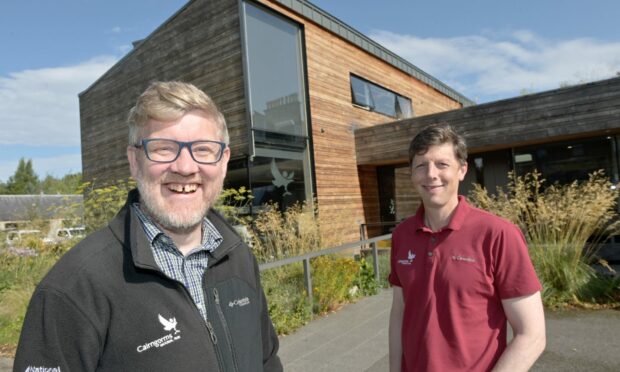The guardians of the Cairngorms National Park believe the area can play a key role in developing jobs for the fight against climate change.
The park authority is already involved in major nature restoration work and says it can help provide green skills and training for the future.
But as it marks its 20th anniversary this month, it is also facing a range of challenges as diverse as the vast area it oversees.
Protecting wildlife, managing a growing number of visitors and avoiding wildfires are among the priorities.
But so too is building affordable housing, curbing second homes and retaining and attracting people and jobs.
Jobs, houses and climate impacts
Writing for the P&J, Grant Moir, chief executive of the Cairngorms National Park Authority, says the authority recognises the need to create good jobs that work with nature as well as a more sustainable tourism model, more affordable homes and to mitigate climate impacts.
“These issues are now at the forefront of UK politics and this national park, and those around the country, are well-placed to help deliver these vital needs.”
The UK’s biggest national park is home to around 19,000 human inhabitants and 25% of the UK’s threatened wildlife species.
It has seen significant investment on visitor facilities, including millions of pounds on upgrading core paths.
This includes a £1.2 million extension to the Speyside Way, when the park authority served a Path Order – the first in Scotland – to ensure it went ahead.
A ranger service now helps with visitor management as numbers coming to the Cairngorms have grown from 1.2 million 20 years ago to 2.1 million today.
There are major projects in peatland and river restoration, woodland expansion and deer management. These will help address climate change targets and create green jobs.
Alongside tourism, they presents potentially massive employment opportunities.
“There are all sorts of training courses provided just now to adapt to new skills. This is one of the places where we have examples of these things happening”, says Gavin Miles, the authority’s head of strategic planning.
“The park is the right place to show people active projects and give practical experience as well as showing outside funders the impact of the things we’re doing.”
Green skills event
Next year the park will host a green skills event with the charity Countryside Learning Scotland.
“The money to do these jobs will definitely come over the next 10 years, it’s already programmed into government. But we need to upskill the workforce”, says Mr Miles.
“The range of jobs is pretty staggering. There is an opportunity for us to get the benefit of the density of work that happens here and the ability to do the training these sectors need.”
The park authority’s workforce has already expanded, from under 60 to 120 in the last 10 years. As well as new rangers, there are dedicated teams for peatland restoration and active travel.
It will learn in December if a bid for £40 million will be successful for the Cairngorms 2030 plans. This includes £12.5 million from The National Lottery Heritage Fund.
This sets out a range of other projects including improving public transport, community health and nature restoration.
More jobs brings a need to build more affordable homes for local and incoming workers.
The park authority has an ambitious target to have 75% of its stock affordable by 2030.
It approved plans last month for up to 33 affordable properties in Aviemore and Nethy Bridge.
Demand is high with average house prices in the park around six times higher than average household incomes.
Grant Moir said: “The economy needs a certain amount of people of working age to keep schools and services working.
“If folk can’t afford to live here we get into a vicious cycle of people having to commute large distances to get to the park or things start to malfunction.”
Second home pressure
Adding to the pressure is the fact around 12% of all houses in the park are second homes. That figure is up to 20% in parts of Badenoch and Strathspey and Deeside.
New short-term let (STL) legislation comes into force next month and Highland Council is setting up a STL control area in Badenoch and Strathspey.
But a ban on second homes is not on the cards.
“There needs to be a bit of honesty in the system”, says Grant Moir.
“If we want to build holiday homes, should we just admit that’s what people are building, rather than a home that gets turned into a holiday home?
“We have nothing against holiday homes per se. But if you have a need for, say, four holiday homes in one place, let’s make sure we have 30 affordable homes for people who want to live and work in the area.
“That’s not daft policy to me, that’s perfectly sensible.”
The rise in visitor numbers has led to issues of overcrowding at certain hotspots and irresponsible behaviour by some.
Loch Morlich fires
A spate of fires, including at least 10 at Loch Morlich, prompted the park authority to consider fire management bye-laws.
However, as well as pressures, most people bring business opportunities.
The aim now is for them to extend their stay and disperse more.
“We’re not saying we want to increase the number of people coming to the park”, says Grant Moir.
“But can they stay longer and spend more in the park? And if there is an increase in numbers can we make sure that’s at times of year when we have less people and there is an opportunity to spread them around the park more?
“If numbers keep increasing in somewhere as environmentally sensitive as the Cairngorms, you’ll have more disturbance, more erosion of paths and greater costs. Eventually there is a tipping point.”
Park is important in attracting customers
Mark Tate, CEO of the Cairngorms Business Partnership (CBP), the area’s chamber of commerce, says the park has succeeded in building the visitor economy and creating jobs.
Surveys show 64% of businesses say it is highly important for attracting first-time customers and 52% for repeat business.
“There is strong evidence businesses believe in the national park and see how it benefits us”, he said.
“There have been lots of jobs created and it attracts lots of visitors.
“But that has created pressures on housing. It has caused quite a significant squeeze on the availability of homes for people who want to work and live in the national park.”
Mr Tate said short term let accommodation is worth around £100 million across the Cairngorms and “we mess with it at our peril”.
He said of 16 short-term let properties leaving the market due to new legislation, 12 have become second homes.
“So they have gone from being economically active 40 weeks of the year to being economically active a couple of weekends a year.
“We need to build more homes, but make sure those that are built are affordable in perpetuity for people to live and work here.”
More community control?
There are currently 71 community owned and managed assets in the area. These range from hydro schemes to heritage attractions and from footpaths to woodlands.
In many cases they have been supported by the park authority which has plans to devolve further.
One of the projects supported by the CNPA is a centre and café for the Laggan Wolftrax mountain biking facility run by Laggan Forest Trust.
Cristian Pizarro, the centre’s business development officer, said: “The national park has been critical to the success of this venture.
“The park authority has played a key role in helping smaller communities achieve ownership of assets and allow profits to be re-invested in the community.”
The Tomintoul and Glenlivet Development Trust also said the authority has been supportive with funding to help developments go from inception to planning and delivery.





Conversation